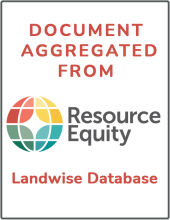Land Library
Welcome to the Land Portal Library. Explore our vast collection of open-access resources (over 74,000) including reports, journal articles, research papers, peer-reviewed publications, legal documents, videos and much more.
/ library resources
Showing items 1 through 9 of 10.The findings of this study demonstrate that the despite the bouquet of land laws and other land reforms that have been put in place to make it easier for women to access land rights, both the formal and informal systems remain fraught with multiple extra-legal obstacles in the form of personal (f
Version française du rapport.
Qu’est-ce qui fonctionne en termes de droits fonciers des femmes? Ce que nous savons et ce qu’il nous reste à savoir
****
Experiences in developing business process for Flexible Land Tenure Act implementation in Gobabis Namibia
Experiences in developing business process for Flexible Land Tenure Act implementation in Gobabis Namibia
This booklet arises from GLTN's work on Islamic dimensions of land which began in 2004 with the commissioning of research leading to Sait and Lim’s “Land, Law and Islam: Property and Human Rights in the Muslim World” (London: Zed Press/UN-Habitat, 2006).
This study aims to examine current land access and youth livelihood opportunities in Southern Ethiopia. We used survey data from the relatively land abundant districts of Oromia Region and from the land scarce districts of Southern Nations, Nationalities and Peoples' (SNNP) Region.
This publication, Innovative Land and Property Taxation, is derived from a 2009 Conference in Warsaw, Poland. It presents the ways in which land and property taxation policies, legal frameworks, tools and approaches to sustainable urban development have been experimented with around the World.
This booklet arises from GLTN's work on Islamic dimensions of land which began in 2004 with the commissioning of research leading to Sait and Lim’s “Land, Law and Islam: Property and Human Rights in the Muslim World” (London: Zed Press/UN-Habitat, 2006).
This booklet arises from GLTN's work on Islamic dimensions of land which began in 2004 with the commissioning of research leading to Sait and Lim’s “Land, Law and Islam: Property and Human Rights in the Muslim World” (London: Zed Press/UN-Habitat, 2006).







